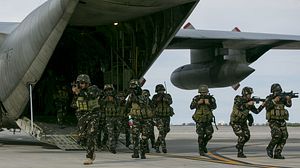Earlier this week, Philippine Foreign Secretary Teodoro Locsin announced that the Philippines would be temporarily suspending its February notice of termination on the U.S.-Philippines Visiting Forces Agreement (VFA). While the move represents an important temporary reprieve for the alliance, it also leaves unresolved the same broader strategic questions bedeviling the relationship under the administration of Philippine President Rodrigo Duterte.
The U.S.-Philippine alliance, born through the Mutual Defense Treaty in 1951, has been no stranger to rounds of stress-testing – be it the renegotiation of base agreement terms in the 1970s or the closure of U.S. military facilities in the early 1990s (which, we should recall, gave rise to the 1999 VFA in the first place after rising Philippine threat perceptions with respect to China). Seen from that perspective, Duterte’s assumption of the presidency has brought about the biggest alliance stress test in decades, with his effort to distance Manila from Washington and pursue closer ties with China and Russia running into some obstacles but still leading to periodic crises and the slowing of U.S.-Philippine cooperation in some areas.
Duterte’s February threat to nix the VFA – which governs the terms under which U.S. military personnel can be temporarily present in the Philippines – constituted the most serious manifestation of this new period of alliance stress-testing under his presidency. Though the VFA is only one facet of U.S.-Philippine defense cooperation, not having it or a replacement would effectively neuter the MDT, undermine the ability of Washington to provide assistance to Manila across a range of challenges including terrorism and China’s South China Sea assertiveness, and complicate U.S. presence in the region at a time when Washington is trying to assert its role in the Indo-Pacific and fashion a more competitive approach towards China.
Given all this, the U.S.-Philippines VFA withdrawal suspension certainly represents an important and welcome temporary reprieve for the alliance. U.S. Ambassador to the Philippines Jose Manuel Romualdez understandably noted that ending the VFA amid the ongoing COVID-19 situation as well as the deteriorating environment in the South China Sea would be far from ideal. But beyond that, a suspension also eases the pressure of the 180-day clock that had begun to tick in February, consuming both bureaucracies and opening a can of worms in terms of the cascading series of decisions that would have to be taken once the VFA is terminated, including serious adjustments of U.S.-Philippine security cooperation and U.S. regional military presence.
Yet it is also worth keeping in mind that the suspension leaves broader issues unresolved that had existed even before the VFA initial termination notice had been issued. Though the conclusion of this specific episode may be postponed, the underlying tension between the continued strategic importance of the alliance, long recognized by bureaucracies and publics on both sides, and Duterte’s own deep-seated personal issues with it will remain out to the end of his single six-year term in June 2022. And as this tension plays out, its management – whether directly through individual exercises or indirectly with Duterte’s China embrace – will continue to preoccupy officials in both countries, periodically distracting from not only sustaining but also reinforcing the alliance in a changing regional environment.
That is not to say that the U.S.-Philippine VFA withdrawal suspension isn’t welcome news for the alliance – it unquestionably is, and advocates on both sides deserve credit for temporarily preventing a major blow to the alliance. But one hopes that that this time gives both sides some breathing room not only to avert the next crisis or carry out ongoing cooperation, but also to get past some of the more fundamental issues in the alliance that cannot simply wait for leadership changes on either or both sides.

































